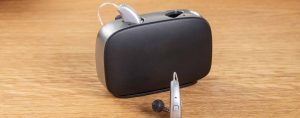HOW A HEARING TEST WORKS AND HOW TO DETECT ANOMALIES

03 April 2020
Updated on June 2nd, 2023
Hearing loss can occur due to various factors such as aging, exposure to noise, or genetic predisposition. It can have a significant impact on your daily life, including communication difficulties and social isolation. Hence, it is crucial to detect hearing loss early to avoid further deterioration and to improve the quality of life. In this article, we will discuss how a hearing test works and how to detect anomalies.
Preliminary Interview
Step 1: Anamnesis
Before the hearing test, the audiologist will start by asking you questions about your hearing problems and medical history. This preliminary interview, known as anamnesis, is necessary to understand your hearing concerns and focus on a particular disorder if necessary. The audiologist may ask about your family’s medical and hearing loss history, recent exposure to loud noise, and your listening habits. This information will help the audiologist determine the type and severity of hearing loss, as well as the impact on your quality of life.
Step 2: The Ear Exam
After the anamnesis, the audiologist will perform an ear exam using an otoscope. This examination is to detect any possible lesions in the ear canal or eardrum, which could be the cause of decreased hearing. The otoscope is a medical instrument with a light and a magnifying lens that helps visualize the ear canal and eardrum. The audiologist will use the otoscope to check for any visible abnormalities, such as earwax buildup, foreign objects, or inflammation.
A Series of Tests in a Soundproof Environment
Step 3: Pure-Tone Audiometry
Pure-tone audiometry is the most common hearing test. It involves analyzing your hearing ability using a series of “pure” sounds, which are single-frequency tones. You will wear headphones and listen to sounds at different frequencies and intensities (low and high). You must indicate when you hear the sound, and the audiologist will record your responses on an audiogram. This test will determine your hearing thresholds, which are the softest sounds you can hear at different frequencies. The results will show if there is any hearing loss, its severity, and type (conductive, sensorineural, or mixed).
Step 4: Tone Test
Tone testing is another type of hearing test that evaluates the hearing thresholds at different frequencies. It is similar to pure-tone audiometry but uses a wider range of frequencies to assess the hearing ability. The audiologist will use the results of the tone test along with the pure-tone audiometry to determine the type and degree of hearing loss.
Step 5: Impedancemetry
Impedancemetry is a test that measures the middle ear’s ability to transmit sound. It is useful in detecting any problems in the middle ear cavity. During the test, the audiologist will place a probe in your ear, which will create changes in air pressure. The results will show the mobility of the eardrum and if there is any fluid in the middle ear. The test will also check for the presence of the acoustic reflex, which is a reflexive contraction of the middle ear muscle in response to loud sounds.
Step 6: Speech Audiometry
Speech audiometry is a test that evaluates your ability to understand speech. The audiologist will ask you to repeat words or sentences spoken at different volumes and background noise levels. The test will determine your speech reception threshold, which is the lowest volume of speech you can hear and understand. It will also evaluate your ability to discriminate between speech sounds, which is important for understanding speech in noisy environments. The results of the speech audiometry test can provide additional information about the type and severity of the hearing loss.
***It should be noted that the number obtained does not indicate the percentage of your hearing loss, but only your ability to discern the words.
Step 7: Typanometry
Tympanometry is a hearing test that examines the eardrum’s mobility and middle ear ventilation. During this test, the audiologist will insert a small probe into your ear canal that changes the pressure in your ear and measures the eardrum’s response. This test helps to detect problems such as a perforated eardrum, fluid in the middle ear, or other issues that affect middle ear function.
The Results
After the hearing tests are complete, the audiologist will review the results with you. The audiogram shows the results of the pure-tone audiometry test and displays the softest sounds you were able to hear at different frequencies. The audiologist will use this information to determine the type and degree of your hearing loss.
If your hearing test shows that you have a hearing loss, the audiologist may recommend hearing aids or other assistive devices to improve your hearing. Based on his or her recommendation, you can then consult a hearing care professional who will advise you on the different hearing solutions that may suit your personal needs. The type of hearing aid recommended will depend on the type and degree of your hearing loss, as well as your lifestyle and communication needs. If you decide to use hearing aids, your hearing care professional can help you choose the right type of device and adapt it correctly over the months and years. Audioprosthetists, members of the Ordre des Audioprothésistes du Québec, are the only professionals authorized to sell hearing aids in Quebec.
Regular hearing tests are important for identifying hearing problems early and preventing further hearing loss. If you have any concerns about your hearing or if you work in a noisy environment, it is recommended that you see an audiologist for a hearing test every two years. With early detection and intervention, you can improve your hearing and prevent further hearing loss.
Take care of your hearing by getting it tested regularly; it’s best for your well-being and your socio-professional life.
References
- American Speech-Language-Hearing Association. (n.d.). Pure-Tone Audiometry.
Retrieved from https://www.asha.org/public/hearing/Pure-Tone-Audiometry/ - American Speech-Language-Hearing Association. (n.d.). Speech Audiometry.
Retrieved from https://www.asha.org/public/hearing/Speech-Audiometry/ - Mayo Clinic. (2021). Tympanometry.
Retrieved from https://www.mayoclinic.org/tests-procedures/tympanometry/about/pac-20384676 - National Institute on Deafness and Other Communication Disorders. (2019). Hearing Tests.
Retrieved from https://www.nidcd.nih.gov/health/hearing-tests
Autres articles
HEARING IMPAIRMENT: THE DIFFERENT TYPES AND DEGREES OF HEARING LOSS
Hearing loss isn’t the same for everybody: in fact, it may involve just one ear or both, affect the outer…
BENEFITS OF A RECHARGEABLE HEARING AID
TNowadays, some manufacturers offer cutting-edge hearing aids with rechargeable induction batteries. This avoids the need to regularly change batteries and…
BUYING HEARING AID BATTERIES: WHAT ARE THE DIFFERENT OPTIONS?
Hearing aids are support systems for hearing that transmit external sound waves to a hearing-impaired person by adapting and transforming…


